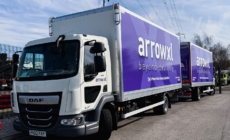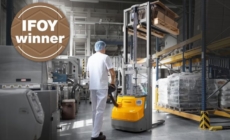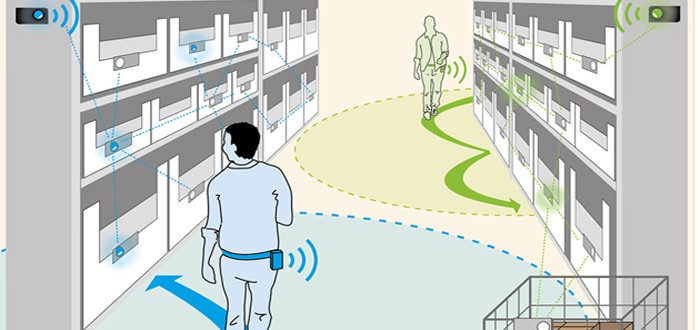-
ROSSLARE EUROPORT TARGETS HEALTH & SAFETY WITH CAMERA TELEMATICS PARTNERSHIP - 2 days ago
-
Landmark Study Reveals Wearable Robotics Significantly Boost Safety and Efficiency in Industrial Environments - July 24, 2024
-
Visku Tackle The Retail Seasonality Challenge One Pallet At A Time - July 22, 2024
-
KAMMAC AND BERGEN LOGISTICS STRENGTHEN FASHION & LIFESTYLE SERVICES IN THE UK - July 19, 2024
-
TENTBOX EXTENDS PARTNERSHIP WITH ARROWXL TO SUPPORT INCREASING DEMAND - July 17, 2024
-
The Perfume Shop improves customer journeys while driving profitability in partnership with Scurri - July 17, 2024
-
ZEROMISSION SECURES £2.3M ($3M) INVESTMENT TO ACCELERATE ELECTRIC FLEETS - July 16, 2024
-
BCMPA CELEBRATES SUCCESS OF 2024 CONFERENCE - July 15, 2024
-
Best of the Best: Jungheinrich Celebrates Triple International Award Win - July 12, 2024
-
GOPLASTICPALLETS.COM CALLS ON NEW CHANCELLOR RACHEL REEVES TO CONSIDER PLASTIC PACKAGING TAX REFORM - July 10, 2024
What really matters when selecting an order picking system?
Voice, light or robot?
The productivity of a logistics center largely depends on the efficiency of the picking process. Selecting the right picking solution thus requires some thought. Important parameters in making that decision are the performance, flexibility and ergonomics of the picking system. Once the selection has been made, it is hard to reverse it because the solution is so closely tied to the design of the overall logistics system. Prior to introducing an order-picking method, companies should work with their system integrator to conduct a strategic analysis of their logistics terms of reference and process requirements.
Anyone planning an order-picking system when building a new logistics center must first make a fundamental decision: Which principle is best for the order positions: goods to person, person to goods or automatically? In the first variant, the required articles are brought from the warehouse to the picker by means of conveyor technology. The picker collects the products for an order in one or several containers. The principle behind person to goods is entirely different. In this case, the picker moves within specific zones to the goods, removes the desired number of articles and places them into an order container. In automatic order picking, however, no manual action is needed. Which method is best suited to a company depends on the specific application.
A closer look at the logistics requirements
Designing the order-picking process and accounting for the logistics requirements is an important part of the system planning of an installation. Four parameters should be considered prior to deciding on a specific solution:
• average order size
• scope of the article range
• picking frequency
• weight and dimensions of the articles
Goods to Person
To use the goods to person (GTP) principle, articles must be organized in an automatic storage and retrieval system. Once this requirement is met, the solution reveals its advantages best with a large and frequently changing range of articles. This makes it relevant, for example, for e-commerce. The logistics manager does not have to worry about dividing and organizing the order picking shelves because the articles are conveyed as needed from a high-bay racking store to the picker’s location. This solution is ideal for rarely requested B and C articles since no other storage space is needed apart from the high-bay racking store. Because the picker has no search time, picking efficiency is high when the GTP principle is used. This effect is even greater when several orders are collected at the same time. The technical implementation of the GTP principle uses screens at the picking stations that display article information and the number of items to be picked. By means of a put-to-light system, the picker sees which order container a piece of merchandise is to be placed into.
Person to goods
When picking products according to the person to goods (PTG) principle, all articles are accessed directly. This method is thus specifically suited to picking A articles as well as generally for smaller article ranges with a high throughput. Since the bin sizes are variable, the handling and processing of bulky goods is also no problem. Another advantage is that system performance is easy to improve by increasing personnel placement and making negligible investments, e.g. in handheld devices, while GTP systems have a fixed limit of capacity. However, in a PTG system a fixed storage location must be defined in advance for every article that must be retained in the medium term. Also the picker’s longer search times mean a lower pick rate compared to the GTP principle. To optimize the work process in terms of time and distance, articles frequently needed should be placed at a central position and ideally easily within reach. To save time, multi-order picking in which several orders are picking during the course of a tour lends itself to this method. The most common techniques used as part of the picker to goods principle are pick-by-light, pick-by-voice, pick-by-vision, and pick-by-handheld.
Robot-assisted order picking
Despite the increasing degree of automation used in logistics centers, automatic order picking systems have in the past primarily been used for special applications in which merchandise of a uniform size of a similar weight are picked in very large numbers. This is true, for example, of applications in the pharmaceutical or tobacco industries. In these applications, automatic systems perform better and have a lower error rate. The disadvantages, however, are the high cost of investment and the limited flexibility of the solutions, such as in changing the range of items. Implementation of automatic order picking is handled, for example, by unit sorters that use chutes to convey articles to a transport belts or by suction cup systems that allows a robot to pick up an article. Another area in which automatic systems are used is two-stage picking. In this method, the total amount of articles required for a number of orders is placed on a conveyor belt. In a second step, automatic sorters allocate the articles to the individual orders. This method efficient processes large numbers of small orders, e.g. in e-commerce. Two-stage semi-automatic order picking is expedient for applications with a large variety of articles and a frequently changing assortment.
Special case retrofitting: the solution has to fit the system layout
Compared to a new build in which the system layout is secondary to the logistics requirements, the warehouse topology has an impact on the decision in favor of an order picking system when it comes time to modify or modernize existing facilities. The frequent storage and retrieval of articles according to the goods to person principle requires efficient storage and retrieval systems and heavy-duty conveyor technology. The warehouse should also have as many aisles as possible. This topology makes it possible to remove several containers from different warehouse areas at the same time and thus deliver items rapidly to picking stations. Another option is the shuttle warehouse integration consisting of several lift units. The static retrieval of goods at fixed storage locations according to the PTG principle, however, can also be used efficiently with a conveyor technology of lower capacity or in a manually operated warehouse. Replenishments just have to be delivered by means of the conveyor technology or manually with this solution. Automatic order picking systems require a conveyor technology specifically designed for it, making them the most cost-intensive solution.
The technology assists people
Factors such as ergonomics, handling or worker preferences also play a role when deciding how orders are to be picked. Even an outstanding solution is useless if it is not ergonomic and cannot be operated intuitively. Some workers perceive systems as unpleasant that overtax certain sensory organs and require a constant high level of concentration. The upward line of sight required for pick-by-vision, for example, or the frequent spoken commands required for pick-by-voice can ultimately be stressful and result in a drop in performance when used over longer periods. From an ergonomic perspective, systems are ideal that are seamlessly inserted into existing work processes and do not limit freedom of movement. An ergonomic workstation design is supported by the GTP system: in this case, the table height can be set individually and the articles to be picked can be placed at a convenient picking position. In a PTG system, however, it is unavoidable that shelves are arranged over several levels and in some cases that the routes to be covered are long.
Outlook: the future of order picking
State-of-the-art order picking systems already offer a high degree of flexibility. Several methods may be used simultaneously to meet different requirements – such as fast and slow moving articles – and to exploit their respective advantages. Companies and research institutes are currently working on further improvements for the picking process. Pickers in future will be supported by artificial intelligence systems from the field of robotics. In human-robot teams, automated colleagues may help human pickers by taking over repetitive tasks or lifting heavy loads, thereby improving ergonomics and reducing the risk of accident. Given the lack of skilled workers and the increasing length of working lives, the future potential of the man-machine cooperation is great. Another approach already being discussed at logistics fairs is pick-by-local-light, a more flexible variant of pick-by-light. Instead of rigid pick-by-light tracks, wireless sensor networks are used that communicate with each other. The advantage: compartment displays can be placed anywhere as needed, even on pallets or other load carriers. The user is thus independent of the rigid shelving systems employed by classic pick-by-light systems. This increases the flexibility of picking and reduces installation costs. Pick-by-local-light can have great advantages especially in industries with a frequently changing assortment, like e-commerce.
About the author:
Dr.-Ing. Ralf Lüning has been Managing Director at Unitechnik Systems GmbH responsible for the Sales and Technology divisions since 2015. At the Schaeffler group, he was responsible for global further development of logistics as head of Supply Chain Development. At the io-consultants planning company, Dr. Lüning served as Senior Business Unit Manager for logistics and factory planning projects in Germany and Asia. He studied Mechanical Engineering at TU Ilmenau and took his doctorate in the subject area order picking systems.

































